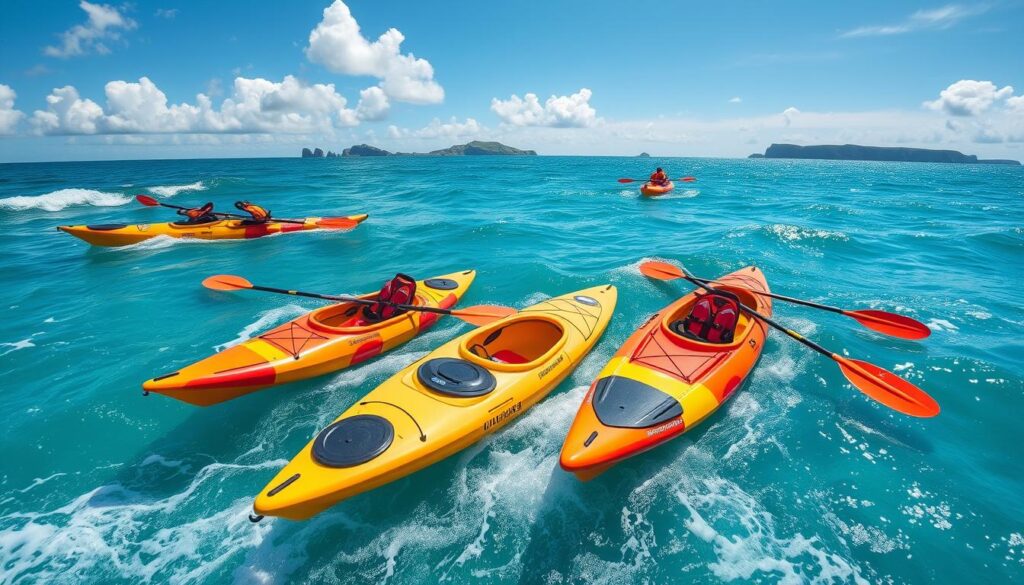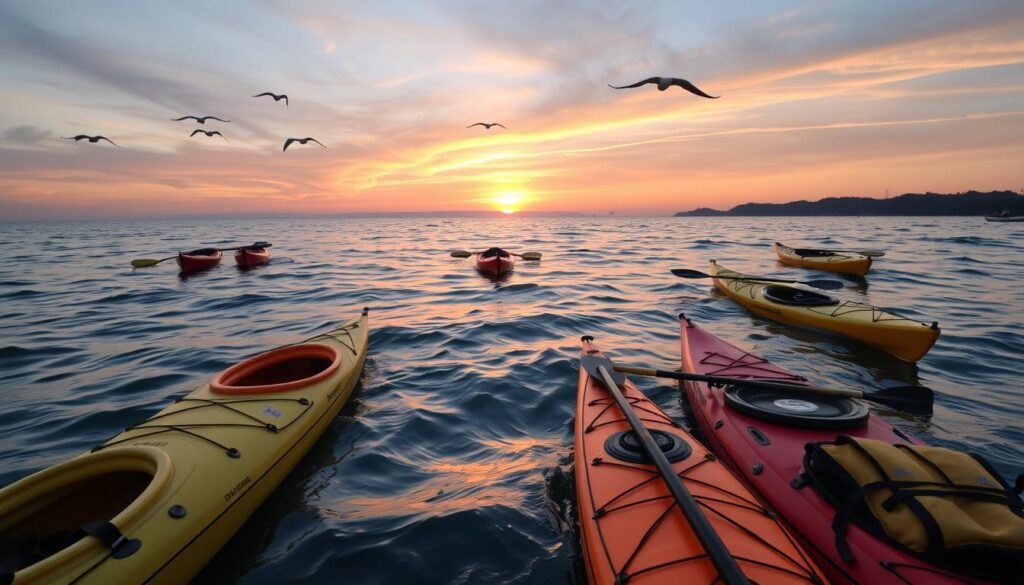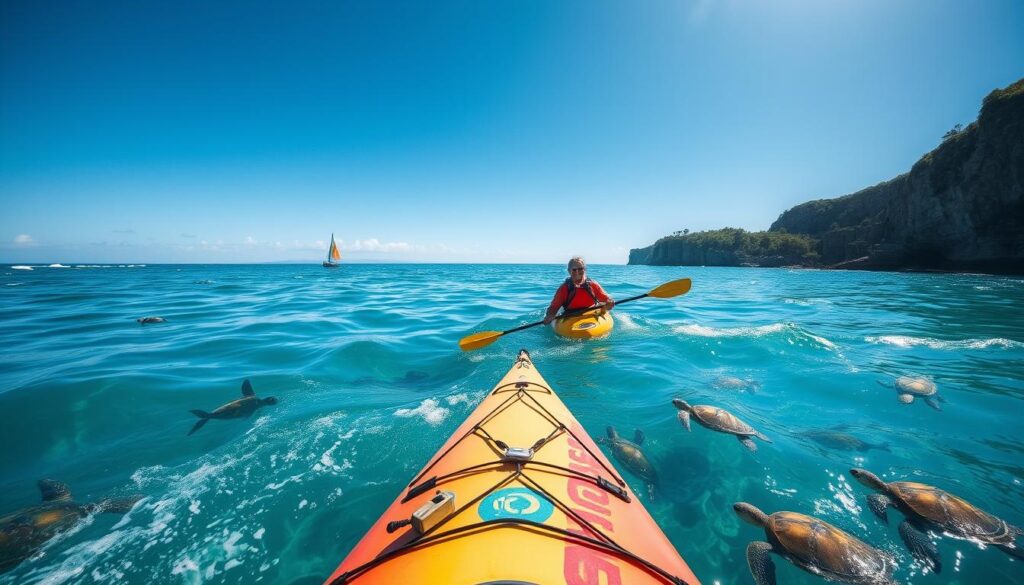Ocean kayaking is an exciting adventure for those who love water sports. Many paddlers wonder “can any kayak go in the ocean?” The answer is no – not every kayak is made for the ocean’s rough waters. It’s important to know what kayak is safe for ocean kayaking before you start.
- Key Takeaways
- Understanding Ocean Kayaking Basics
- Can Any Kayak Go in the Ocean? Safety and Suitability Explained
- Types of Ocean-Ready Kayaks
- Design Features That Make a Kayak Ocean-Worthy
- River Kayaks vs Ocean Kayaks: Key Differences
- Essential Safety Equipment for Ocean Kayaking
- Weather and Ocean Conditions for Safe Kayaking
- Best Practices for First-Time Ocean Kayakers
- Maintaining and Preparing Your Kayak for Ocean Use
- Conclusion
- FAQ

When you think about kayaking in the ocean, check your kayak’s design and build. The ocean’s waves, currents, and wind need a kayak that can handle them. Kayak experts say you need a special kayak for the sea.
Choosing the right kayak is key to a safe and fun ocean kayaking trip. Different kayaks perform differently in the ocean. You need to pick one that fits your skill level and the trip you have planned.
Key Takeaways
- Not all kayaks are suitable for ocean use
- Specialized ocean kayaks provide better safety
- Hull design impacts maritime performance
- Understanding ocean conditions is critical
- Proper equipment ensures a successful ocean kayaking experience
Understanding Ocean Kayaking Basics
Ocean kayaking is a thrilling adventure that’s different from paddling in freshwater. A common question newcomers ask is “can any kayak go in the ocean safely?” When you start exploring coastal waters, you’ll find a unique environment that requires specific kayak designs and features.

Key Differences Between Ocean and Freshwater Kayaking
Ocean kayaking has its own set of challenges. It’s different from paddling in rivers or lakes. The main differences include:
- Unpredictable water conditions
- Saltwater environment
- Greater physical demands
Essential Ocean Conditions to Consider
Before you start your ocean kayaking adventure, you need to know about key environmental factors. Wind speed, wave height, and water temperature are all important for your safety and fun.
“The ocean demands respect and preparation from every kayaker.” – Professional Ocean Kayaking Guide
Impact of Tides and Currents
Tides and currents can greatly affect your ocean kayaking experience. Knowing about these natural forces helps you plan safer routes. It also helps you anticipate any challenges you might face.
| Ocean Factor | Impact on Kayaking |
|---|---|
| High Tide | Easier coastal access, more navigational options |
| Low Tide | Potential obstacles, restricted movement |
| Strong Currents | Increased physical challenge, navigation difficulty |
Understanding these basic principles is key to success in ocean kayaking. With the right preparation, what could be a risky experience becomes an exciting adventure.
Can Any Kayak Go in the Ocean? Safety and Suitability Explained
Not every kayak is made for ocean waters. The kayak you choose can greatly affect your safety. Ocean kayaking needs special gear that can handle tough marine conditions.

When you think about ocean kayaking, you need to look at a few key things:
- Kayak hull design
- Material durability
- Length and stability
- Weather resistance
Professional kayakers say certain kayaks are best for the ocean. Touring and sea kayaks are built for rough waters. They are longer and more streamlined, making them better at cutting through waves.
“Choosing the right kayak is your first line of defense in ocean safety” – Expert Paddling Association
Recreational kayaks aren’t good for the ocean. They don’t have the right features for unpredictable sea conditions. Sit-on-top and sit-inside sea kayaks do better, with better tracking and stability in tough waters.
Your safety depends on picking the right kayak for the ocean. Always do your research and get a kayak made for marine environments. This way, you’ll have a safe and fun kayaking experience.
Types of Ocean-Ready Kayaks
Choosing the right kayak for ocean adventures is key. You need to know about different kayak designs and what they can do. Not all kayaks are good for coastal waters.
While not any kayak can go in the ocean successfully, certain designs are specifically built for maritime conditions. Choosing the right kayak for ocean adventures is key.
Sit-On-Top vs Sit-Inside Designs
Ocean kayaking needs special gear. Sit-on-top kayaks are great for the sea because they:
- Drain water easily
- Are easy to get back into if you flip
- Stay stable in rough water
Sit-inside kayaks offer other benefits. They keep you dry and work well for those who know the sea.
Touring and Sea Kayaks
Sea kayaks and touring kayaks are different. Sea kayaks have:
- Long, narrow hulls
- Great for tracking
- Best in rough seas
Touring kayaks are more versatile. They’re good for both the coast and calm waters. They balance speed and stability well.
Recreational Kayaks for Ocean Use
Some recreational kayaks can handle mild ocean conditions. Look for ones with:
- Strong build
- Enough width for stability
- Features to keep water out
Always put safety first. Make sure your kayak fits your experience level when you’re out on the ocean.
Design Features That Make a Kayak Ocean-Worthy
Not all kayaks are good for ocean kayaking. The right design is key for a safe trip. Knowing what makes a kayak ocean-ready is important for paddlers.
Ocean kayaking needs special designs for better performance and safety. Here are the main features to look for:
- Hull Shape: A longer, narrower hull tracks better and goes faster in open waters
- Increased Length-to-Width Ratio: This makes the kayak more stable and easy to maneuver in tough ocean conditions
- Sealed Bulkheads: They keep water out and help the kayak stay buoyant
The best ocean kayaks have special design elements:
| Design Feature | Purpose in Ocean Kayaking |
|---|---|
| Rocker Profile | Helps navigate wave patterns and improve maneuverability |
| Deck Height | Lower decks reduce wind resistance and improve stability |
| Material Durability | Reinforced materials resist saltwater corrosion and impact |
“A well-designed kayak is your best companion in ocean waters.” – Professional Kayaking Instructor
When picking an ocean kayak, look for designs that offer great stability, tracking, and water displacement. Your safety depends on choosing a kayak made for the ocean’s dynamic environment.
River Kayaks vs Ocean Kayaks: Key Differences
Choosing the right kayak is all about knowing the key differences between river and ocean kayaks. They might look similar, but their designs are tailored for different water types.
When picking a kayak, think about where you’ll paddle. The gap between river and ocean kayaks is bigger than many think.
Hull Design Comparisons
River kayaks have:
- Shorter, more agile hulls
- Wider bottoms for better stability in rough waters
- Round edges for easy turns
Ocean kayaks, on the other hand, have:
- Longer, smoother hulls
- Narrower shapes for better tracking
- Sharp edges to slice through waves
Stability Features
Stability is a big deal for both river and ocean kayaks. River kayaks are made for quick turns, while ocean kayaks aim for steady tracking in the sea.
Storage and Safety Features
Ocean kayaks come with extra safety features:
- Several watertight areas
- More deck rigging
- Bigger storage for longer trips
“Not all kayaks are created equal. Your water environment dictates your ideal kayak design.” – Professional Kayaking Association
Knowing these differences will help you choose the best kayak for your adventures.
Essential Safety Equipment for Ocean Kayaking
Ocean kayaking requires careful preparation and the right safety gear. Your survival depends on having the proper equipment in coastal waters. Knowing what to pack can make a big difference between a safe trip and a dangerous one.
When you start kayaking in the ocean, you need critical safety equipment. This gear protects you from harm:
- Personal Flotation Device (PFD)
- Marine-grade communication devices
- Emergency signaling equipment
- First aid kit
Your personal flotation device is the most important safety item. Choose a PFD made for ocean kayaking. It offers more mobility and protection against water conditions.
| Safety Equipment | Purpose | Recommended Type |
|---|---|---|
| PFD | Personal Flotation | Coast Guard Approved Type III |
| Communication Device | Emergency Contact | Waterproof Marine Radio |
| Signaling Device | Rescue Visibility | Whistle, Mirror, Flares |
| Navigation Tool | Location Tracking | GPS, Compass |
Professional kayakers suggest carrying multiple communication devices. A waterproof marine radio is key for contacting rescue services in emergencies.
“Preparation is the key to safe ocean kayaking. Never underestimate the importance of proper safety equipment.” – Professional Kayaking Instructor
Always check your safety gear before you go. Make sure everything is secure and works well. Being prepared can prevent serious problems during ocean kayaking adventures.
Weather and Ocean Conditions for Safe Kayaking
Ocean kayaking needs a good understanding of the environment. You must check the weather and ocean conditions before you go.
Being good at ocean kayaking is not just about skills. You also need to watch nature’s signs and understand how things work together.
Reading Weather Patterns
Good kayakers use many sources to guess the weather:
- Marine weather forecasts
- Wind speed and direction indicators
- Barometric pressure changes
- Cloud formation patterns
Understanding Wave Heights
Wave height is key for safe kayaking. Different waves need different skills:
| Wave Height | Kayaking Difficulty | Recommended Experience |
|---|---|---|
| 0-2 feet | Beginner | New paddlers |
| 2-4 feet | Intermediate | Experienced kayakers |
| 4-6 feet | Advanced | Expert ocean kayakers |
Navigating Coastal Waters
Coastal waters are tricky for kayakers. Tides, currents, and the area’s shape change a lot. You need to stay alert and flexible.
“Knowledge of the ocean is the kayaker’s most valuable safety equipment.” – Professional Ocean Kayaking Guide
Always check the local marine forecast before kayaking. Know your skill level and pack the right safety gear.
Best Practices for First-Time Ocean Kayakers
Starting your ocean kayaking journey needs careful planning and knowledge. Your first time can be thrilling and a bit tough. Knowing the key safety tips will make you feel more confident on the water.
Before you hit the ocean, make sure you do these important steps:
- Take professional kayaking lessons specific to ocean conditions
- Learn basic water safety and self-rescue techniques
- Practice paddling skills in controlled environments
- Invest in proper safety equipment
Choosing the right spot is key for a great kayaking trip. Start with calm, sheltered areas. These spots have little wave action and easy currents.
“Knowledge and preparation are your best companions in ocean kayaking.” – Professional Kayaking Instructor
Here are some critical skills for ocean kayaking:
- Understanding tide and current patterns
- Reading weather forecasts
- Mastering proper paddling techniques
- Maintaining situational awareness
Your gear choices are very important for safety and fun. Here are some must-haves:
| Equipment | Purpose | Recommendation |
|---|---|---|
| Personal Flotation Device | Safety | Coast Guard-approved |
| Wetsuit | Temperature Protection | Appropriate to water conditions |
| Communication Device | Emergency Contact | Waterproof mobile or marine radio |
Always put safety first when kayaking in the ocean. Start slow, learn as you go, and cancel if you’re unsure about the weather.
Maintaining and Preparing Your Kayak for Ocean Use
Ocean kayaking requires careful care and preparation. This ensures your kayak stays in top shape. Salt water can damage kayaks, so regular maintenance is key.
Before you start your ocean kayaking journey, make sure to follow these important steps:
- Rinse your kayak with fresh water after each trip in saltwater
- Check the hull for any damage or wear
- Apply lubricant to moving parts and hardware
- Keep your kayak in a cool, dry place, away from sunlight
Protecting your kayak from saltwater is essential. Saltwater can quickly damage your kayak’s materials if not cared for properly.
“A well-maintained kayak is your best companion on ocean adventures” – Professional Ocean Kayaker
Here are some key maintenance practices:
| Maintenance Task | Frequency | Purpose |
|---|---|---|
| Fresh Water Rinse | After Each Use | Remove Salt Residue |
| Hardware Check | Monthly | Prevent Corrosion |
| Full Inspection | Annually | Assess Overall Condition |
Spending time on proper kayak maintenance will make your ocean kayaking gear last longer. It also ensures safe and fun times on the water.
Conclusion
Ocean kayaking is an exciting adventure that needs careful planning and the right gear. It’s important to know how to choose the best kayak for the ocean. Learning about the differences between river and sea kayaks helps a lot.
Safety is key in ocean kayaking. This guide has shown how important it is to pick a kayak that fits the coastal conditions. Whether you go for a sit-on-top or a touring kayak, it affects your safety and how well you do.
As you start your ocean kayaking journey, always keep learning and preparing. Understand the ocean, practice safety, and build your confidence slowly. Every kayaker began where you are now, eager to explore the sea safely and enjoyably.
Your dedication to learning about kayaks, safety, and the sea will make ocean kayaking a great experience. Stay curious, be ready, and enjoy the amazing world of ocean kayaking with respect for the sea.
FAQ
Can I use any kayak in the ocean?
Not all kayaks are good for the ocean. Sea kayaks and touring kayaks are made for the sea. They have longer hulls and are more stable in rough waters. Recreational kayaks might not be safe in the ocean.
What’s the difference between a sea kayak and a river kayak?
Sea kayaks are longer and narrower for better speed in open water. They also have sealed bulkheads for safety. River kayaks are shorter and more agile for tight turns and rapids. Their designs and stability are very different.
Are sit-on-top or sit-inside kayaks better for ocean kayaking?
Both have their own benefits. Sit-on-top kayaks are stable and easy to get back into if you flip. They’re great for beginners and warm waters. Sit-inside kayaks offer better protection and are more efficient for long tours, especially in tough conditions.
What safety equipment do I need for ocean kayaking?
You’ll need a Coast Guard-approved PFD, a marine radio, and signaling devices like a whistle and flares. Don’t forget navigation tools, a waterproof phone, a first aid kit, a bilge pump, and the right clothes for the water. Always check the weather and local rules before you go.
How do ocean conditions affect kayaking?
Ocean conditions can change your kayaking experience a lot. Tides, currents, waves, and wind can be dangerous. You need to know the weather, tides, and have good paddling skills to stay safe.
What should I consider when choosing an ocean kayak?
Look at the hull design, length, stability, storage, and material. Choose kayaks with sealed compartments and good tracking. Longer kayaks (16-18 feet) are best for ocean tours.
How do I prepare my kayak for saltwater use?
Rinse your kayak with fresh water after each use to remove salt. Check for damage and apply protective coatings. Use materials that won’t corrode and maintain your kayak well.
What skills do I need for ocean kayaking?
You need to know how to rescue yourself, navigate, read the weather and tides, and paddle well. Take courses on ocean kayaking to learn and feel safe.

